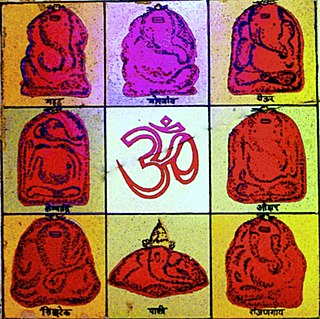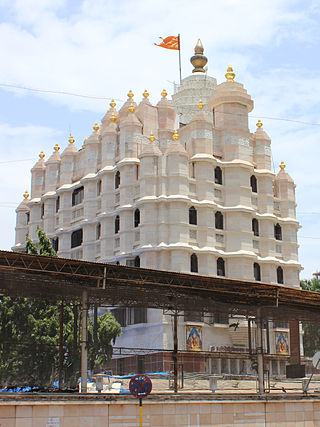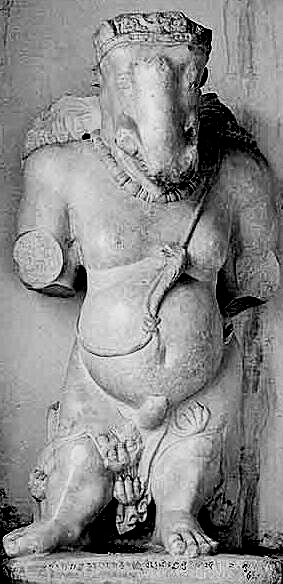Related Research Articles

Ashtavinayaka is a Sanskrit term which means "eight Ganeshas". The Ashtavinayaka yatra trip refers to a pilgrimage to the eight Hindu temples in the state of Maharashtra, India, centered around the city of Pune, that house eight distinct idols of Ganesh, in a pre-ascertained sequence. Ganesh is the Hinduism/Hindu deity of unity, prosperity, learning, and removing obstacles. Each of these temples has its own individual legend and history, as distinct from each other as the murtis in each temple. The form of each murti of Ganesh and his trunk are distinct from one another. There are other temples of eight Ganesh in various other parts of Maharashtra; however, the ones around Pune are more well known and visited. It is believed that to complete the Ashtavinayak Yatra, one must revisit the first Ganpati after visiting all the eight Ganpatis.

Ganesh Chaturthi, also known as Vinayak Chaturthi, or Ganeshotsav is a Hindu festival commemorating the birth of the Hindu god Ganesha. The festival is marked with the installation of Ganesha's clay idols privately in homes and publicly on elaborate pandals. Observances include chanting of Vedic hymns and Hindu texts, such as prayers and vrata (fasting). Offerings and prasada from the daily prayers, that are distributed from the pandal to the community, include sweets such as modaka as it is believed to be a favourite of Ganesha. The festival ends on the tenth day after start, when the idol is carried in a public procession with music and group chanting, then immersed in a nearby body of water such as a river or sea, called visarjan on the day of Anant Chaturdashi. In Mumbai alone, around 150,000 statues are immersed annually. Thereafter the clay idol dissolves and Ganesha is believed to return to his celestial abode.

Varadvinayak, also spelt as Varadavinayaka, is one of the Ashtavinayak temples of the Hindu deity Ganesha. It is located in Mhad village situated in Khalapur taluka near Karjat and Khopoli of Raigad District, Maharashtra, India. The temple was built (restored) by Peshwa General Ramji Mahadev Biwalkar in 1725AD.

The Shree Siddhivinayak Ganapati Mandir is a Hindu temple dedicated to Lord Shri Ganesh. It is located in Prabhadevi, Mumbai, Maharashtra, India. It was originally built by Laxman Vithu and Deubai Patil on 19 November 1801. It is one of the richest temples in India.

Ganesha, also known as Ganapati,Vinayaka, and Pillaiyar, is one of the best-known and most worshipped deities in the Hindu pantheon and is the Supreme God in Ganapatya sect. His image is found throughout India. Hindu denominations worship him regardless of affiliations. Devotion to Ganesha is widely diffused and extends to Jains and Buddhists and includes Nepal, Bangladesh, Sri Lanka, Indonesia, Thailand, Myanmar, China, and Japan and in countries with large ethnic Hindus populations including United States, Fiji, Guyana, Mauritius, and Trinidad and Tobago.
Galaganath is a small village located near Haveri, in the Haveri District, Karnataka. Located here is the famous Galageshwar Shiva Temple built during the rule of the Western Chalukyas. This large temple faces east and is situated along the Tungabhadra River. The rivers Tunga and Varada join at Galaganath.

Kapilash Temple, also known as Mahadev Chandrashekhar Temple is situated in the north eastern part of Dhenkanal town, Odisha, India at a distance of 26 km from the district headquarters.

Bhoramdeo Temple is a complex of Hindu temples dedicated to the god Shiva in Bhoramdeo, in the Indian state of Chhattisgarh. It comprises a group of four temples of which the earliest is a brick-temple.

The Siddhivinayaka Mahaganapati Temple is a Hindu temple located in Titwala, a small town in the Kalyan taluka of Thane district – near Mumbai, Maharashtra, India. The temple is dedicated to the Hindu, elephant-headed god of wisdom Ganesha. Titwala is believed to be the putative site of the hermitage of sage Kanva, foster parent of Shakuntala who was born here. The place is steeped in ancient legend and the temple is frequented by a very large number of devotees on account of the belief that separated married couples could be united and marriages of desired people could be fixed easily if the Ganesha image installed in the temple is worshipped with devotion.This temple is frequented mostly on Tuesdays.
Chintaman Ganesh is the biggest temple of Lord Ganesha in Ujjain of Madhya Pradesh, India. This temple is built across the Kshipra river on the Fatehabad railway line, and is located about 7 km far south-westerly to the Ujjain town. The temple is located now in the middle of the town's market.

Ranjangaon Ganpati is one among the Ashtavinayak, celebrating eight instances of legends related to Ganesha. This temple's Ganpati idol was inaugurated and donated by the "Khollam" family, a goldsmith family based in Ranjangaon. The temple was built between the 9th and 10th century. The main temple looks like it was built in the Peshwa period. Nagarkhana is situated above the entrance gate. The temple facing east has huge and beautiful entrance gate.
Urkeri is a small village located in the district of Uttar Kannada in the state of Karnataka in India. It has a population of about 963 persons living in around 214 households. Urkeri is a temple Village. The main deity is Lord Ganesh. Lord Ganesha is revered as the village God in these villages, in the north Kanara district. The chariot ceremony of Ganapati is celebrated on Maghi Pournima. The temple is the main attraction at Urkeri, receiving many devotees per year. Urkeri Shree Swayambhoo Devasthana is an ancient temple.
Saptamaruka Temple is Hindu temple in Jajpur in the Indian state of Odisha. Temple is dedicated to Hindu Tantric and Puranic goddesses Saptamatrikas.

Garh Ganesh Temple is an 18th-century temple of Lord Ganesh in the city of Jaipur. It is located on the hills near Nahargarh Fort and Jaigarh Fort.

The Chintamani Temple of Theur is a Hindu temple dedicated to Ganesha Located 25 km (16 mi) from Pune, the temple is "one of the larger and more famous" of the Ashtavinayaka, the eight revered shrines of Ganesha in the Indian state of Maharashtra.

The Siddhivinayak Temple of Siddhatek is a Hindu temple dedicated to Ganesha, the elephant-headed god of wisdom. The temple is one of the Ashtavinayaka, the eight revered shrines of Ganesha in the Indian state of Maharashtra and the only Ashtavinayaka shrine in Ahmednagar district.

The Vigneshwara Temple or Vighnahar Ganapati Temple of Ozar is a Hindu temple dedicated to Ganesha, the elephant-headed god of wisdom. The temple is one of the Ashtavinayaka, the eight revered shrines of Ganesha in Maharashtra, India. The Ganesha form worshipped here is called Vigneshwara or Vignahar and is associated with the legend of Ganesha defeating Vignasura, the demon of obstacles.

Vinayaki (Vināyakī) is an elephant-headed Hindu goddess. Her mythology and iconography are not clearly defined. Little is told about her in Hindu scriptures and very few images of this deity exist.
Bohra Ganesh Temple is a very old and famous temple of Lord Ganesh, situated near Mohanlal Sukhadia University in Udaipur. Having a standing statue of Lord Ganesh at the center, this temple is visited by thousands of devotees every week.

The Gardez Ganesha is a statue of the Hindu god Ganesha, discovered in Gardez, near Kabul in Afghanistan. It is considered as "a typical product of the Indo-Afghan school". It was dedicated by a king named Khingal.
References
- ↑ "Archaeological survey Indira Gandhi National Centre for the Arts" (PDF). Archived from the original (PDF) on 21 June 2011. Retrieved 20 November 2010.